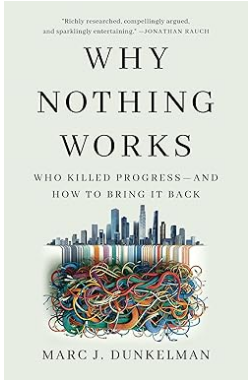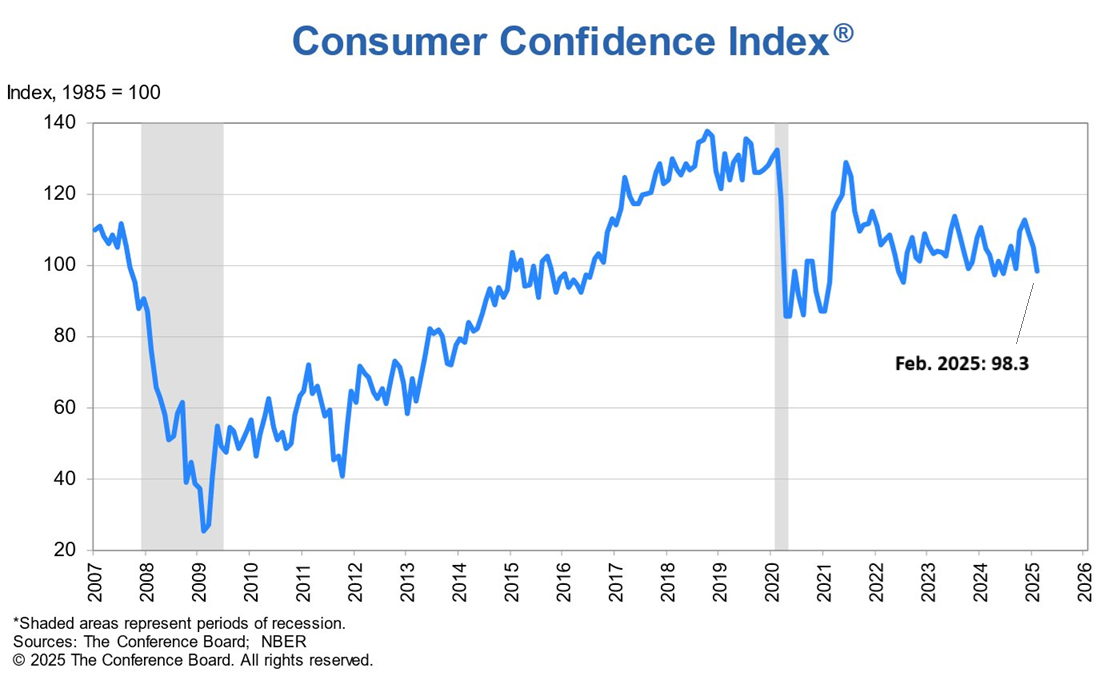New US home sales fell sharply in January. “New home sales will continue to struggle with fewer homes coming to market due to tepid buying activity,” says CoreLogic chief economist Selma Hepp. “Even though homebuilders continue to offer buyer incentives, high mortgage rates, mixed with continued price appreciation, keep the eligible pool of homebuyers restricted to higher income individuals.”
Are Markets Rethinking The Prospects For Trump 2.0?
Recent headlines appear to have shaken investor sentiment. It’s premature to read too much into a few days of weaker-than-expected survey numbers. More importantly, the latest data indicate that the economy is still growing, businesses continue to hire, and the near-term outlook for consumer spending remains positive. But the White House would do well to consider the implications of the recent slide in Main Street’s sentiment. The financial markets seem to be doing just that.
Macro Briefing: 26 February 2025
US Consumer Confidence Index fell sharply in February, marking the biggest monthly decline since 2021. “This is the third consecutive month on month decline, bringing the Index to the bottom of the range that has prevailed since 2022,” said Stephanie Guichard, a senior economist at The Conference Board. “Average 12-month inflation expectations surged from 5.2% to 6% in February.”
Politics And Policy Clouds Path Ahead For Fed
The central bank’s job is never easier, but in the current climate it’s unusually tricky.
In addition to the usual challenges that complicate real-time monetary-policy decisions, the Federal Reserve must weigh the potential economic implications from a blizzard of edicts from the White House. It’s unclear how President Trump’s plans have altered the Fed’s expectations, but private sector economists are weighing in on the outlook.
Macro Briefing: 25 February 2025
US economic activity slowed in January, according to the Chicago Fed National Activity Index. Two of the index’s four broad categories decreased from December, and one category made a negative contribution in January.
Foreign Stocks, Commodities Lead Major Asset Classes This Year
The year so far is shaping up to be quite different from 2024 in terms of leaders and laggards for the major asset classes. Global equities ex-US are the leaders, along with a broad measure of commodities, based on a set of ETFs through Friday’s close. The formerly high-flying US equities market, by comparison, is posting relatively modest results year to date.
Macro Briefing: 24 February 2025
US economic activity “falters and payrolls decline in February, as optimism slumps and costs rise,” according to the latest update of the US PMI Composite Output Index, a survey-based GDP proxy. This month’s initial estimate for the index is 50.4, a 17-month low that’s just slightly above the neutral 50 mark that separates growth from contraction.
Book Bits: 22 February 2025
 ● Why Nothing Works: Who Killed Progress―and How to Bring It Back
● Why Nothing Works: Who Killed Progress―and How to Bring It Back
Marc J. Dunkelman
Interview with author via NPR
Q: When New York City built its subway system in the first part of the 1900s, it took about three years to build the first subway line through Manhattan. It’s impossible to do anything in three years in the United States today, certainly anything of that scale. What do you make of that comparison?
A: I think that’s exactly right. We had a long period in our history where we gave centralized power to certain authority figures to make big decisions that were designed to help everybody. And often they weren’t beneficial. Sometimes they were abusive. There are lots of stories where we awoke to that in the 1960s and seventies.
Real (Inflation-Adjusted) Treasury Yields Remain Elevated
At a time of increased uncertainty about inflation, the relatively elevated real yields available in inflation-indexed Treasuries offer a partial antidote of certainty for anxious investors.
Macro Briefing: 21 February 2025
US jobless claims edged higher last week, but remain at a level that prevailed prior to the pandemic. “New claims have trended lower since last August as the 13-week moving average touched 218,000 after peaking at 235,000, a sign that the labor market remains strong,” writes an analyst at RSM.




